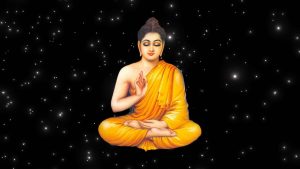📖 The book The Buddha Teaches Once More
🔹 Part 2: Essential Buddhist Teachings
📜 Chapter 22: The Noble Eightfold Path
In the teachings of the Buddha, the Noble Eightfold Path is regarded as the essential path leading to enlightenment and liberation from suffering. The Buddha expounded that by following the Eightfold Path, practitioners can progress toward attaining the four stages of sainthood—Sotāpanna (Stream-enterer), Sakadāgāmi (Once-returner), Anāgāmi (Non-returner), and Arahant (Fully Enlightened One).
Furthermore, through studying the hidden meanings within the Heart Sutra, Minh Nguyet has realized that Avalokiteśvara Bodhisattva encourages sentient beings to stay steadfast on this path. Thus, understanding and applying the Noble 8-Fold Path is an indispensable foundation for anyone on the journey of spiritual cultivation.
Minh Nguyet: Venerable Buddha, in the Heart Sutra, Avalokiteśvara Bodhisattva contemplated deeply and realized that by following the Noble Eightfold Path, sentient beings can attain peace and tranquility within their hearts.
Therefore, I humbly request you to expound further on the Noble 8-Fold Path, so that sentient beings may gain correct understanding and learn how to apply the Buddha’s teachings into their daily lives.

The Noble Eightfold Path is translated into Vietnamese as “Bát Chánh Đạo”. Initially, we need to understand the word “Chánh”. “Chánh” means “right” or “correct”, and it is the opposite of “tà”, which means “wrong” or “deviant”.
The Noble Eightfold Path includes Right View, Right Thought, Right Speech, Right Action, Right Livelihood, Right Effort, Right Mindfulness, and Right Concentration.
The Noble 8-Fold Path
⓵ Right View
Right View is translated into Vietnamese as “Chánh Kiến,” where “Chánh” means “correct” or “right,” and “Kiến” means “seeing” or “understanding.”
Therefore, Right View refers to training oneself to always have a correct understanding. In society, right and wrong are often mixed and intertwined, so we need Right View to distinguish between what is right and wrong in such confusion. To achieve Right View, we must also cultivate Right Intention.
⓶ Right Thinking
We need to have correct thinking when forming opinions or making decisions. For example, in our spiritual practice, when we think about walking on our own two feet (which means relying on our own efforts), that is Right Thinking. On the contrary, thinking based on seeking favors from higher beings is wrong thinking.
⓷ Right Speech
A practitioner must speak truthfully, avoiding fabrication or making statements that are incorrect, as these may cause harm to oneself or others. We should only communicate information that we are certain is accurate. If we are unsure, we should refrain from sharing to avoid misleading others and causing negative effects. Additionally, we should avoid speaking arrogantly; instead, practitioners should demonstrate humility and show respect toward others.
⓸ Right Action
Karma refers to the results of one’s actions, including actions of body, speech, and mind. Merit and blessings are considered Right Action. Practicing the precepts well will help us cultivate Right Action.
⓹ Right Livelihood
Right Livelihood is translated into Vietnamese as “Chánh Mệnh”, where “Mệnh” refers to the body and one’s fate. Therefore, using your body and fate to engage in righteous and beneficial work is called Right Livelihood.
⓺ Right Effort
We must cultivate good karma and eliminate bad karma. Once we have chosen the correct path, we should not give up or cheat in our efforts to progress in practice; this is called Right Effort. Conversely, giving up or cheating during the practice is considered Wrong Effort.
⓻ Right Mindfulness
Right Mindfulness means being aware in three aspects: body, speech, and mind. This means:
- The body always chooses to do good deeds;
- The speech always expresses positive and kind words;
- The mind is always directed toward virtuous and positive thoughts.
We must always hold the notion of doing good, avoid practicing dishonestly, and observe the precepts diligently; this is Right Mindfulness. To cultivate Right Mindfulness, we need good thoughts to guide our actions according to moral standards.
Remember, observing the precepts means maintaining everything within ethical boundaries and moral standards.
⓼ Right Concentration
Right Concentration includes both steadfastness and mental focus. When we achieve the previous seven “Right” qualities, our mind will naturally settle. True concentration comes from a stable and unconflicted mind, and only this can be called Right Concentration. If the mind is unstable or dependent on external factors, it is merely false concentration.
For example, someone who starts out poor but later gains money may feel more at ease, thinking their mind is settled because they worry less about material needs. However, this type of concentration is temporary, based on material wealth, and is not true Right Concentration.
When we realize the truth that all sentient beings possess inherent emptiness, and that we are born from the Supreme God with the noble goal of becoming Buddhas, we understand that this world is a temporary place for spiritual training. Each sentient being must engage in personal cultivation. With this realization, we remain steadfast in our resolve to follow the Buddha’s path, walking on our own feet and diligently cultivating ourselves. This is the world-transcending form of concentration, not dependent on worldly desires.
Note that: In this, Right View and Right Intention are two important factors that complement each other. Right View is the correct and impartial understanding of things and phenomena, without bias. But to achieve Right View, we must use correct thinking to analyze and form our own opinions. Right View is the opposite of Wrong View.
Easily believing and following the opinions of others, without self-reflection and thoughtful consideration, is considered Wrong View.
For example, in the Age of Declining Dharma, which is the current age, there are many demons and also many opposing doctrines emerging. We need to have correct thinking to distinguish and not arbitrarily follow others’ words. The Supreme God deliberately arranges this: some people play the role of evil, while others play the role of good. The purpose is to help us develop discernment and thereby awaken our own wisdom.
🍃Conclusion:
The Noble Eightfold Path essentially revolves around the concept of “rightness”, and these eight right paths are closely interconnected. When remembering the Noble 8-Fold Path, we only need to remember that we must always be upright and practice self-reliance in our cultivation, through continuous learning, without clinging to or seeking divine intervention, and avoiding superstition and false beliefs.
In particular, it is crucial to practice Right View and Right Intention well, as these are the foundational elements for the other Right paths. By practicing the Noble Eightfold Path diligently, practitioners can feel at ease and relaxed on their spiritual journey, free from fear.




